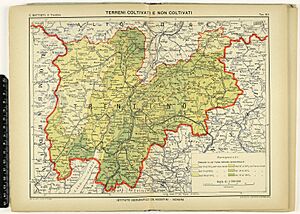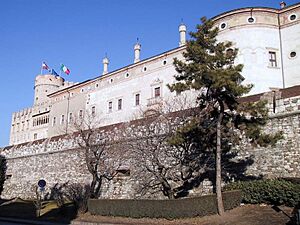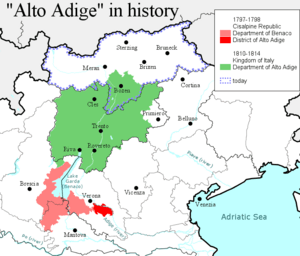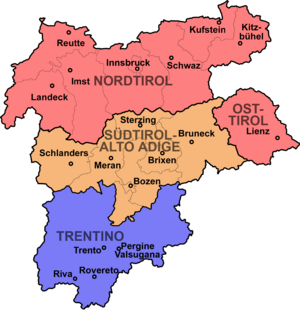History of Trentino facts for kids
The history of Trentino is a long and interesting journey! Trentino is a beautiful region in northern Italy. Its story began way back in the middle of the Stone Age. It continues all the way to today, where Trentino is a special part of the Italian Republic.
Contents
Ancient Times in Trentino
Early Settlers and the Stone Age
Long, long ago, during the Stone Age, people already lived in the valleys of what is now Trentino. They mostly settled in the Adige River valley. This area had a milder climate, which made it a good place to live.
Scientists believe the first people were hunters. They likely came from the Padana Plain and the Venetian Prealps. This happened after the huge glaciers started to melt at the end of the Ice Age.
We know this from things found in the ground. For example, burial sites from the Mesolithic period have been found. These are in places like Zambana and Mezzocorona. A large hunting camp from the Neolithic period was also found. It was near the Colbricòn lakes, close to the Rolle Pass.
The Raetians and Roman Rule
Around 500 BC, a group called the Raetians arrived in the Trentino area. They came from the central and eastern Alps. They settled in many valleys. They brought new skills like farming (grapes, vegetables, grains) and raising animals (sheep, goats, cows, and horses). Before them, people mainly hunted.
The Romans fully conquered this region in the 1st century BC. The Raetians were finally defeated near Bolzano. This happened during military campaigns led by Drusus and Tiberius around 16-17 BC.
Trento became a Roman town (called a municipium) in the 40s BC. Later, under Emperor Claudius (41-54 AD), Trentino became part of the Roman road network. Important roads like the Via Claudia Augusta Padana were built. Claudius also gave Roman citizenship to people in this region. By the 300s AD, the area was fully Romanized, meaning people spoke Latin and followed Roman customs.
The Prince-Bishops of Trent
Invasions and New Beginnings
After the Roman Empire started to decline, Trentino faced many invasions in the 400s AD. First came the Ostrogoths, then the Bavarians and Byzantines. Finally, the Lombards took control. During the Lombard rule, the idea of Trentino as its own area (called Tridentinum territorium) began to form. Around this time, most people in the region became Christians.
In 774, the Franks conquered Trentino. It became part of the Kingdom of Italy. This kingdom was sometimes a loose part of what would become the Holy Roman Empire.
A Special Kind of Rule
Trentino gained its first real unity in 1027. This is when Emperor Conrad II officially gave control of the area to the Bishopric of Trent. This meant the bishops of Trent ruled the land. This special arrangement lasted for about 800 years! It gave Trentino a lot of freedom, first from the Holy Roman Empire and later from the Austrian Empire.
Trentino as Part of Austria
The Napoleonic Era and Austrian Rule
In the early 1800s, during the Napoleonic Wars, French armies invaded. Some people from Trentino joined the resistance, led by Andreas Hofer from Tyrol.
In 1810, Napoleon created the Department of Alto Adige. This included most of today's Trentino and the area around Bolzano. It was part of Napoleon's Kingdom of Italy for a few years.
After Napoleon's defeat in 1815, the Bishopric of Trent ended. Trentino then became part of the County of Tyrol. Most people in Tyrol spoke German.
A Desire for Italy
Even though Trentino was well-governed by Austria, a movement grew in the late 1800s. This movement, called Italian irredentism, wanted Trentino to join the newly unified Kingdom of Italy. This idea was mainly pushed by thinkers like Cesare Battisti and Fabio Filzi. Many farmers in the area also supported it.
World War I and Its Impact
Because of its location, Trentino was very important if Austria-Hungary and Italy went to war. So, in the early 1900s, Austria-Hungary built strong forts there. These forts were meant to protect against an Italian attack. They also served as a place for Austrian troops to prepare for an attack on Northern Italy.
When Italy joined World War I in 1915, Trentino became a major battleground. It suffered a lot of damage. More than 55,000 Trentini soldiers fought for Austria. They fought against Russia and Serbia, and then against Italy starting in 1915. Even though they spoke Italian, very few Trentini soldiers deserted. Over 10,000 of them died, and many more were hurt or captured. Also, hundreds of thousands of civilians had to leave their homes because they were too close to the front lines. Many were sent to southern Italy.
Trentino Joins Italy
After World War I, the Treaty of Saint-Germain (1919) was signed. This treaty officially united Trentino with Italy. It joined with the new Province of Bolzano/Bozen (South Tyrol). Together, they formed a region called Venezia Tridentina.
During the time of Fascist rule in Italy, the government became more centralized. This meant cities like Trento and Rovereto lost some of the freedom they had before. Many smaller towns were also combined, reducing their number from 366 to 127.
Modern Autonomy
Self-Rule After World War II
After World War II, a special agreement was made. The Italian and Austrian foreign ministers, Alcide De Gasperi and Karl Gruber, signed a treaty. This led to the creation of the autonomous region of Trentino-Alto Adige/Südtirol. This meant the region had more power to make its own decisions.
In the years that followed, the main political party in Trentino was the Christian Democracy. However, some people wanted even more self-rule. In 1957, there was some tension between Trentino and the German-speaking South Tyrol. This led to the popular slogan Los von Trient ("Away from Trento"), meaning South Tyrol wanted more independence from Trento. In 1972, the regional government's powers were given to the two provinces, Trentino and South Tyrol.
Growth and Cooperation Today
In the 1960s and 1970s, Trentino saw strong economic growth. This was mainly thanks to tourism and its new self-governing status. Today, Trentino is one of the richest and most developed provinces in Italy.
In 1996, the Euroregion Tyrol-South Tyrol-Trentino was formed. This group includes the Austrian state of Tyrol and the Italian provinces of South Tyrol and Trentino. The borders of this group are the same as the old County of Tyrol. The main goal is to promote peace, understanding, and cooperation in many areas. The assemblies of these regions often meet together. They even have a shared office in Brussels to work with the European Union.





